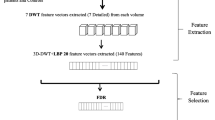Abstract
Alzheimer's disease (AD) is one type of dementia. It is a brain disorder disease that primarily affects people over the age of 60, but it is now affecting middle age people also. Various techniques have been developed to find and control the disease. At present, the research is carried out for the prediction of AD at its early stage. While using large datasets, feature extraction process is one of the issues of the disease prediction. Efficient early categorization of the AD and mild cognitive impairment (MCI) from cognitive normal (CN) is necessary as prompt preventive care could assist to reduce risk factors. So, neuro-imaging-based diagnosing system for Alzheimer disease (NIDS-AD) is proposed here. In this proposed method, feature extraction is performed and then classification is done on the dataset using machine learning algorithms. Discrete wavelet transform (DWT) is used to extract the features, and the extracted features are reduced using principal component analysis technique. Then, the extracted feature coefficients are used to represent the image as input for the classification process. Decision tree (DT) and linear discriminant analysis (LDA) are the two classifiers used for the classification process. Finally, DT classifier obtains accuracy value of 93.3% which is better than LDA classifier.
Access this chapter
Tax calculation will be finalised at checkout
Purchases are for personal use only
Similar content being viewed by others
References
Davatzikos C, Bhatt P, Shaw LM, Batmanghelich KN, Trojanowski JQ (2011) Prediction of MCI to AD conversion, via MRI, CSF biomarkers, and pattern classification. Neurobiol Aging 32(12):2322-e19
Nordberg A, Rinne JO, Kadir A, Långström B (2010) The use of PET in Alzheimer disease. Nat Rev Neurol 6(2):78–87
Bhuvaneshwari B, Kavitha A (2017) Investigations on the brain connectivity patterns in progression of Alzheimer's disease using functional MR imaging and graph theoretical measures. In: 16th IEEE international conference on cognitive informatics and cognitive computing, pp 151–160. ICCI* CC, IEE
Magnander T, Wikberg E, Svensson J, Gjertsson P, Wängberg B, Båth M, Bernhardt P (2016) A novel statistical analysis method to improve the detection of hepatic foci of 111 In-octreotide in SPECT/CT imaging. EJNMMI Phys 3(1):1–12
De Visschere P, Nezzo M, Pattyn E, Fonteyne V, Van Praet C, Villeirs G (2015) Prostate magnetic resonance spectroscopic imaging at 1.5 tesla with endorectal coil versus 3.0 tesla without endorectal coil: comparison of spectral quality. Clinical Imaging 39(4):636–641
Mahanand BS, Suresh S, Sundararajan N, Kumar MA (2012) Identification of brain regions responsible for Alzheimer’s disease using a self-adaptive resource allocation network. Neural Netw 32:313–322
Jeurissen B, Leemans A, Sijbers J (2014) Automated correction of improperly rotated diffusion gradient orientations in diffusion weighted MRI. Med Image Anal 18(7):953–962
Hamelin L, Bertoux M, Bottlaender M, Corne H, Lagarde J, Hahn V, Sarazin M (2015) Sulcal morphology as a new imaging marker for the diagnosis of early onset Alzheimer’s disease. Neurobiology of aging 36(11):2932–2939
Yang G, Zhang Y, Yang J, Ji G, Dong Z, Wang S, Feng C, Wang Q (2016) Automated classification of brain images using wavelet-energy and biogeography-based optimization. Multimedia Tools Appl 75(23):15601–15617
Moon YS (2015) Super-resolution image reconstruction using wavelet based patch and discrete wavelet transform. J Sig Proc Syst 81(1):71–81
Akhila DB, Shobhana S, Fred AL, Kumar SN (2016) Robust Alzheimer's disease classification based on multimodal neuroimaging. In: IEEE international conference on engineering and technology, pp 748–752. IEEE
Zhang YD, Wang S, Dong Z (2014) Classification of Alzheimer disease based on structural magnetic resonance imaging by kernel support vector machine decision tree. Progress Electromagnetics Res 144:171–184
Li, C., Fang, C., Adjouadi, M., Cabrerizo, M., Barreto, A.: A Neuroimaging feature extraction model for ımaging genetics with application to AD. In:17th IEEE ınternational conference on bioinformatics and bioengineering, pp 15–20. IEEE (2017)
Ragavamsi D, Ragupathy R (2020) A survey of different machine learning models for alzheimer disease prediction. Int J Emerg Trends Eng Res 8:3328–3337
Dimitriadis SI, Liparas D (2018) How random is the random forest? Random forest algorithm on the service of structural imaging biomarkers for Alzheimer's disease: from ADNI database. Neural Regeneration Res 13(6):962
Sarmento RM, Vasconcelos FFX, Rebouças Filho PP, Wu W (2020) Automatic neuroimage processing and analysis in stroke—a systematic review. IEEE Rev Biomed Eng 13, 130–155
Author information
Authors and Affiliations
Editor information
Editors and Affiliations
Rights and permissions
Copyright information
© 2022 The Author(s), under exclusive license to Springer Nature Singapore Pte Ltd.
About this paper
Cite this paper
Davuluri, R., Rengaswamy, R. (2022). Neuro-imaging-based Diagnosing System for Alzheimer’s Disease Using Machine Learning Algorithms. In: Saini, H.S., Sayal, R., Govardhan, A., Buyya, R. (eds) Innovations in Computer Science and Engineering. Lecture Notes in Networks and Systems, vol 385. Springer, Singapore. https://doi.org/10.1007/978-981-16-8987-1_53
Download citation
DOI: https://doi.org/10.1007/978-981-16-8987-1_53
Published:
Publisher Name: Springer, Singapore
Print ISBN: 978-981-16-8986-4
Online ISBN: 978-981-16-8987-1
eBook Packages: Intelligent Technologies and RoboticsIntelligent Technologies and Robotics (R0)




